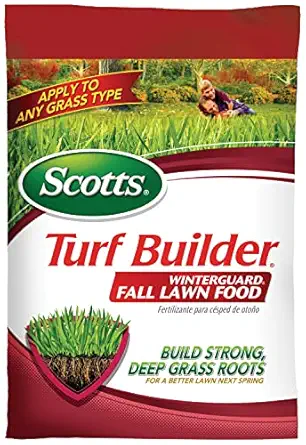Fall is a transitional season for Bermuda grass as it begins to prepare for dormancy. Proper care during this time ensures the lawn remains healthy through the winter and comes back strong in spring.
Here’s a detailed guide to the tasks you should perform in the fall for a thriving Bermuda grass lawn.
Fall (September – November) Bermuda Grass Care Guide
1. Adjust Mowing Practices
As temperatures cool and growth slows, adjust your mowing routine.
- Why: Maintains lawn health while preparing for dormancy.
- How:
- Gradually raise the mowing height to 1.5–2 inches.
- Continue mowing until growth ceases, typically after the first frost.
- Frequency: Mow less frequently as growth slows in late fall.
2. Fertilize with a Potassium-Rich Fertilizer
Switch to a fertilizer high in potassium and low in nitrogen.
- Why: Strengthens the grass’s roots and improves winter hardiness.
- How:
- Apply a fall or winterizer fertilizer (e.g., 5-10-30) at the recommended rate.
- Water the lawn after application to help nutrients absorb.
- When: Early to mid-fall, before the first frost.

Scotts Turf Builder WinterGuard Fall Lawn Fertilizer for All Grass Types
3. Water Deeply but Reduce Frequency
Bermuda grass needs less water as it slows down for dormancy.
- Why: Prevents drought stress without encouraging excess growth.
- How:
- Water deeply, providing about 0.5–1 inch of water per week.
- Stop watering entirely once the grass goes dormant.
4. Aerate the Lawn (If Needed)
If the soil is compacted or the lawn has heavy thatch, aerate in early fall.
- Why: Improves root access to air, water, and nutrients before dormancy.
- How:
- Use a core aerator to remove plugs of soil.
- Water the lawn a day or two before aerating for easier penetration.
5. Apply Pre-Emergent Herbicide
Prevent cool-season weeds from establishing during the winter.
- Why: Reduces competition for nutrients and ensures a clean lawn in spring.
- How:
- Use a pre-emergent herbicide targeting winter weeds like poa annua.
- Apply evenly and water lightly to activate.
- When: Early fall, when soil temperatures drop below 70°F.
6. Overseed with Ryegrass (Optional)
If you want a green lawn during winter, overseed with a cool-season grass like perennial ryegrass.
- Why: Keeps the lawn green while Bermuda grass is dormant.
- How:
- Scalp the Bermuda grass by mowing at the lowest setting.
- Spread ryegrass seed evenly, then water lightly and regularly until germination.
- When: Early to mid-fall, after temperatures cool but before the first frost.
7. Dethatch if Necessary
Remove excess thatch to improve air and nutrient penetration.
- Why: Prevents thatch buildup from stunting growth and harboring pests.
- How:
- Use a dethatching rake or power dethatcher.
- Collect and dispose of the debris, then water the lawn.
8. Perform Final Weed Control
Spot-treat any remaining weeds with a post-emergent herbicide.
- Why: Ensures weeds don’t gain a foothold before winter.
- How:
- Use a selective herbicide appropriate for broadleaf or grassy weeds.
- Follow product instructions to avoid harming the grass.
9. Maintain Edges and Borders
Give your lawn a clean, finished look before the growing season ends.
- Why: Prepares the lawn for a tidy appearance during dormancy.
- How: Use an edger to create sharp lines along pathways and garden beds.
10. Remove Debris Regularly
Keep your lawn free of leaves, twigs, and other debris.
- Why: Prevents debris from smothering the grass and promoting fungal diseases.
- How:
- Rake or use a leaf blower to remove debris as it accumulates.
- Compost or dispose of the collected material.
11. Monitor for Pests and Diseases
Pests and diseases can still pose a threat during the fall.
- Why: Prevents damage that could weaken the grass before dormancy.
- How:
- Inspect the lawn for signs of pests (e.g., grubs) or diseases (e.g., large patch).
- Treat issues promptly with the appropriate insecticide products.
12. Winterize Your Irrigation System
Prepare your irrigation system for freezing temperatures.
- Why: Prevents damage to pipes and sprinklers.
- How:
- Drain water from hoses, sprinklers, and irrigation lines.
- Blow out the system with compressed air if necessary.
Summary of Fall Tasks
| Task | Timing | Frequency |
|---|---|---|
| Mow Adjustments | Early to Late Fall | Weekly to Biweekly |
| Potassium Fertilizer | Early to Mid-Fall | Once |
| Watering | Early Fall | Weekly |
| Aeration | Early Fall | Once (If Needed) |
| Pre-Emergent Herbicide | Early Fall | Once |
| Overseeding (Optional) | Early to Mid-Fall | Once |
| Dethatching | Early Fall | Once (If Needed) |
| Weed Control | Throughout Fall | As Needed |
| Debris Removal | Throughout Fall | Weekly |
| Irrigation Winterization | Late Fall | Once |
By performing these tasks, you’ll help your Bermuda grass lawn enter dormancy in peak condition, setting the stage for a healthy and vibrant return in spring.